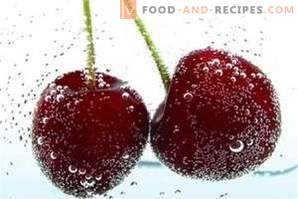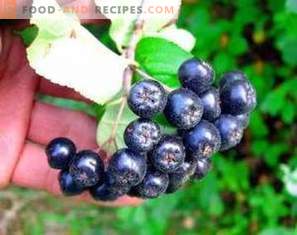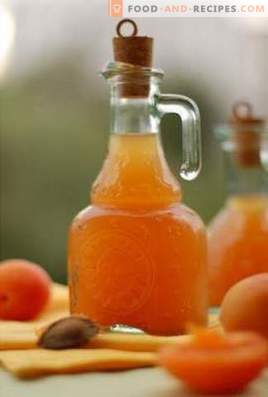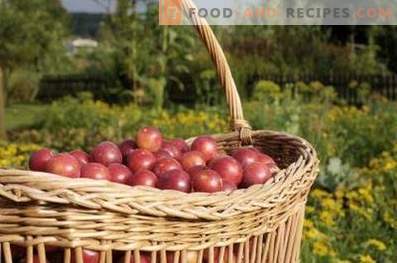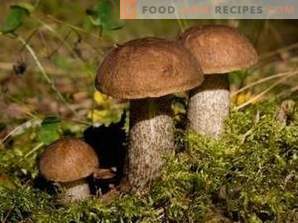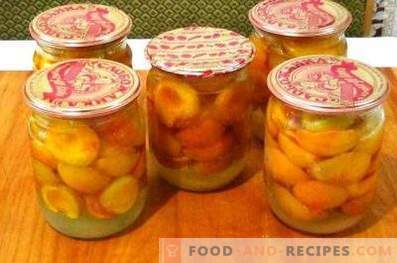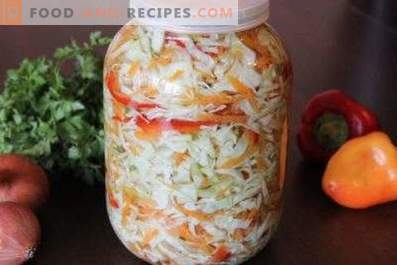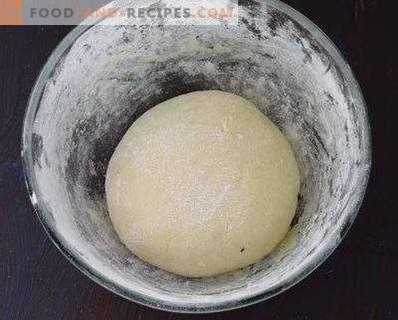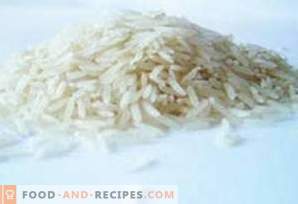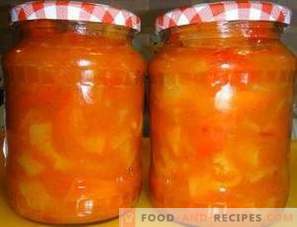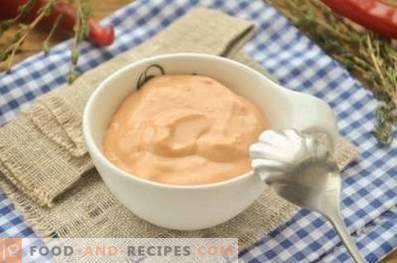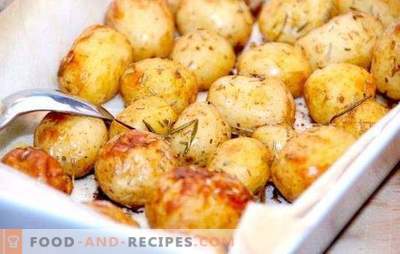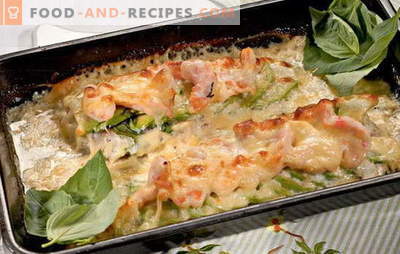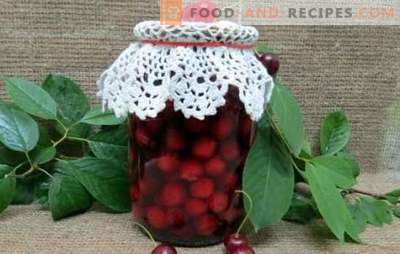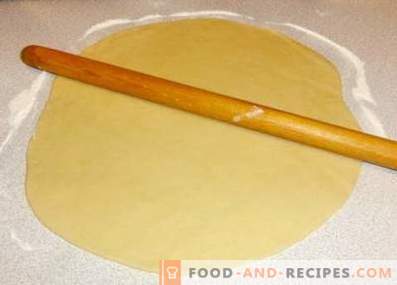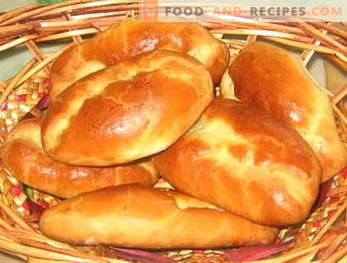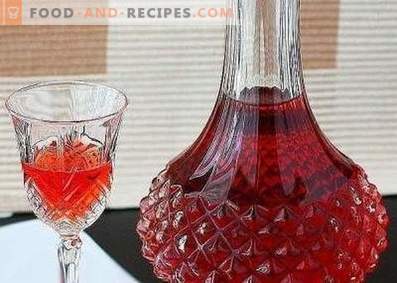
The berry season begins with the advent of strawberries and, of course, sweet cherries.
In favorable conditions, sweet cherry yield is significantly higher than cherries. This berry is in great demand both among amateur gardeners and housewives, who make her compotes, jams, used in cooking.
The cherry is sown quickly, and if it is not collected on time, it becomes unsuitable for canning. Thoughtful owners have found another use for this berry. They make wine of it.
Subtleties
- Only ripe berries with no signs of rot are suitable for wine. Rotten fruit, even in small quantities, can ruin a whole batch of wine.
- Cherries for wine are used both with and without stones. But it is believed that the wine made from sweet cherry with pits is more tart and may be slightly bitter.
- Cherries are not washed for wine, so as not to destroy the yeast that is on the surface of the berries. They are a good leaven, thanks to which the cherry juice (pulp) wanders, turning into wine. If the sweet cherry is too dirty, it can be washed, but in this case, starter is surely added to the pulp.
- From sweet cherry wine turns out rather strong and tart. And the sweeter the berry, the more alcohol it will be.
- In order to increase the natural acidity, winemakers recommend putting a cherry wine with cherry berries added to it. You can also put citric acid in the wort. It will contribute to better storage of finished products.
Sweet Cherry Wine: First Recipe
Ingredients:
- sweet cherry - 10 kg;
- water - 500 ml;
- sugar - 1 kg;
- citric acid - 25 g.
Preparation Method
- Untidy berries sort out, remove the spoiled. Remove the bones from them. This should be done above the capacity to save the juice, which will necessarily flow out of the berries.
- Place the cherry in enamel, plastic or glass dish. Pour in water. Mix well. Cover the dishes with a cloth and place them in a room with an air temperature of 20-22 °. After a few hours, the pulp will begin to ferment, a foam cap will appear on the surface. 3-4 times a day, mix the pulp with your hand or a wooden spoon.
- After three days, carefully crush the pulp. Drain the wort into the bottle, filling it in 2/3 volume, so that there is enough space for fermentation of the juice. Add 400 g of sugar, citric acid and mix thoroughly. Now is the time to close the bottle with a water seal or a stopper with a drain tube, the end of which is immersed in a jar or bottle of water. Put the bottle in a warmer room, but the temperature there should be no higher than 25-27 °.
- After 3-4 days, pour a small amount of juice and mix with 300 g of sugar. Pour the sugar solution into the wort. Close the cork again and let it sit for another 3 days. Then add the remaining sugar and mix well.
- Leave the wine alone for about 25-30 days. During this time, the fermentation will practically stop, various impurities will settle to the bottom. The wine will begin to lighten up. Prepare a second clean bottle. With the help of a thin hose, pour the wort into it, trying not to stir the sediment.
- Leave the wine alone for another month. If a sediment appears at the bottom, be sure to pour the wine into a clean container. If this is not done, the wine may peroxide and spoil its taste.
- Pour the wine into glass bottles, filling it to the top to eliminate interaction with air. Close tightly with traffic jams. Put in a dark cool place and leave for settling, or aging. This may take you another month. If there is a precipitate, the wine is again poured.
- Taste the wine. If it is low in sugar, sweeten with sugar syrup prepared with a minimum amount of water: for 800 g of sugar, you need to take 200 ml of water. Add the cooled syrup to the wine according to your taste (approximately 40 g per 1 liter of wine).
- It is recommended to fix the wine with vodka. It should be of good quality, without foreign smell.
- Pour the wine into bottles and cork well. Store horizontally in a cool dark place.
Cherry Wine: Recipe 2
Ingredients:
- sweet cherry - 5 kg;
- water - 0, 5 l;
- sugar - 1, 2 kg;
- citric acid - 25 g;
- bay leaf - 2 pcs .;
- carnation - 2 pcs .;
- tannin - 15 g;
- raisins - handful.
Preparation Method
- The wine will need ripe berries of a sweet cherry, untouched by rot. They do not need to be washed in order not to destroy those natural bacteria that are responsible for fermentation. Remove the leaves and stalk. In order to avoid the smell of almonds in the finished wine, remove the seeds from the berries, trying to preserve the juice produced as much as possible.
- Place the sweet cherry in an enamel saucepan and carefully knead it with your hands or wooden pulp.
- Pour water, mix.
- Put sugar, spices and tannin in the pulp. At a temperature of 70 ° warm up for 15-20 minutes. With this method of processing from the pulp to the wort will move the maximum amount of fragrant and coloring substances.
- After heating the pulp, press. Pour the wort into the bottle. In the pulp, add a little water, stir and squeeze again. Pour out the pulp from the pulp into the wort. Add unwashed raisins. He will replace the leaven. Prerequisite: the volume of liquid should not exceed 2/3 of the volume of the bottle, as the wort will actively ferment, foam will appear, which will occupy the remaining space.
- Close the bottle with a stopper with a drain tube, lower the end into a container with water. Put in a warm place for fermentation. The next day the fermentation will begin and a foam cap will appear. The period of rapid fermentation lasts from 15 to 30 days, depending on the amount of sugar and the temperature in the room. Gradually, the sugar is processed into alcohol and the fermentation process is declining, the particles of the pulp and yeast settle to the bottom.
- When you realize that carbon dioxide is no longer emitted, transfer the wine to another container. Close the cork again and let the wine completely brighten. About a month later it is again drained from the sediment. This procedure may have to be repeated several more times. If you are lazy and do not get rid of impurities settled to the bottom, it will negatively affect the quality of the wine.
- Taste the wine before bottling. If you think that there is little sugar in it, add sugar syrup prepared from 800 g of sugar and 200 ml of water. Sometimes after that fermentation wakes up in wine. To avoid this, the wine can be pasteurized.
- To do this, pour the wine into bottles, leaving some free space - about 2 cm, close the cork and secure it with a string. Put the bottles in a pan with hot water and pasteurize at 60 ° C for 20 minutes. Then remove the twine. This wine is well stored and ripens faster.
Mistress to note
Despite the observance of all the rules for making wine, it sometimes turns sour. What then can be done?
- The film on the surface of the wine appears due to the accumulation of filmy yeast. If it is not removed, the wine eventually becomes watery. It is removed as follows: the end of a thin rubber hose is immersed in a container with wine much lower than the film and drained the wine into another container, without affecting either this film or the sediment, which could possibly appear at the bottom.
- Acetic acid bacteria develop when air is available in a low-alcohol wine. They oxidize the alcohol, and the wine gradually turns into vinegar. Corroded wine can not be fixed. But if the first signs of souring appeared, the wine should be pasteurized, that is, put the bottles in a pan with hot water and heat them at 65 ° C for 20 minutes.
- Lactic acid souring of wine occurs due to improper storage, for example at high temperatures. To prevent damage to the wine, it is stored in a cool place without access to light. Bottles must be in a horizontal position so that the cork is half submerged in the liquid. This method of storage will not allow air to enter the bottle and affect the quality of the wine.
